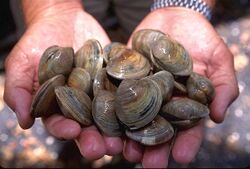Biology:Quahog Parasite Unknown
The quahog parasite unknown, or QPX, is a parasite in the protist kingdom. It affects hard clams, or quahogs,[1] both cultured and wild.[2]
Parasites similar to QPX were first observed in New Brunswick, Canada, in 1959. Outbreaks have also occurred in Nova Scotia, Prince Edward Island, New York, New Jersey, Massachusetts, and Virginia, always only in quahog clams. The life stages of thalli, endospores, and sporangia have been observed.[1][3]
QPX was originally considered a chytrid, but has now been provisionally assigned to the phylum Labyrinthulomycota in either the families Thraustochytriidae or Labyrinthulidae, based on the organism having a "uninucleate biflagellate zoospore stage, a loose multilaminar cell wall, and particularly an intracellular sagenogen-like structure".[4] However, much about it is still unknown.[1] QPX-like organisms also may not be all of the same species.[2]
Symptoms of QPX include chipping of the shells, mantle swelling, stunted shell growth and the development of nodules.[3][2]
References
- ↑ 1.0 1.1 1.2 Ragone Calvo, L.M.; Walker, J.G.; Burreson, E.M. (Jul 30, 1998). "Prevalence and distribution of QPX, Quahog Parasite Unknown, in hard clams Mercenaria mercenaria in Virginia, USA". Diseases of Aquatic Organisms 33 (3): 209–19. doi:10.3354/dao033209. PMID 9745718. http://www.int-res.com/articles/dao/33/d033p209.pdf.
- ↑ 2.0 2.1 2.2 Coen, Loren; Bobo, M. Yvonne; Richardson, Donnia; Anderson, Willam D.. "Sheet for QPX (Quahog Parasite Unknown)". http://www.dnr.sc.gov/marine/mrri/shellfish/QPX.pdf. Retrieved 3 January 2017.
- ↑ 3.0 3.1 "QPX Disease in Hard Clams". Sea Grant New York. http://www.seagrant.sunysb.edu/seafood/pdfs/QPX-Brochure03.pdf. Retrieved 30 October 2016.
- ↑ Ragan, Mark A.; MacCallum, Greg S.; Murphy, Colleen A.; Cannone, Jamie J.; Gutell, Robin R.; McGladdery, Sharon E. (28 September 2000). "Protistan parasite QPX of hard-shell clam Mercenaria mercenaria is a member of Labyrinthulomycota". Diseases of Aquatic Organisms 42. http://www.int-res.com/articles/dao/42/d042p185.pdf. Retrieved 31 October 2016.


